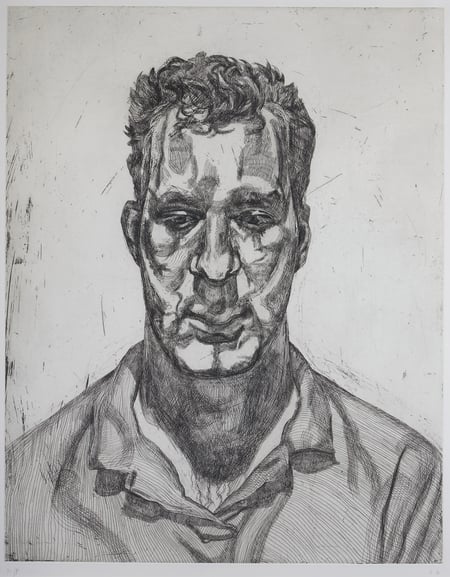On Display: the British printmakers leaving their mark on art history
Pallant House Gallery’s 'Hockney to Himid', which explores the opportunities printmaking has presented to artists working in the last six decades, leaves an impression on Inigo
- Words
- Chloë Ashby

Lubaina Himid’s Birdsong Held Us Together (2020) responds to the comforting soundtrack that continued to play as daily life was put on pause during the pandemic. As the clanging racket of people and traffic subsided, nature rose in volume. In a palette of lemon yellow, juicy orange, sky blue and cobalt, the Turner Prize-winning artist captures the wash of sunshine that accompanied spring last year. A bird occupies each corner, while at the centre, a flower unfurls between a kingfisher and a robin perched on the edge of a nest.
Himid’s sunny lithograph is the curtain call on a new exhibition at Pallant House Gallery in Chichester. Hockney to Himid: 60 Years of British Printmaking celebrates a transformational period in British art with more than 100 modern and contemporary prints by 90 artists. Rewind to the beginning of the show and you’ll find the other individual who lends his name to the exhibition. One of David Hockney’s earliest etchings, Kaisarion with All His Beauty (1961), made while he was at the Royal College of Art, hangs beside a nude portrait of Peter, whom you might recognise from the artist’s splashy California pool paintings. Hockney was part of a generation of British artists studying in the late 1950s and early 1960s who, following in the footsteps of printmaking pioneers such as Enid Marx and John Piper, were engaged with the process of democratising art.
Variety prevails throughout the exhibition, which includes techniques from wood engraving and etching to lithography and digital processes. Works and artists have been carefully chosen and curated to highlight their similarities and differences. A room dedicated to figuration brings together big, bold woodcuts such as Peter Howson’s The Heroic Dosser (1987) and Lucian Freud’s delicate etching of his mother, with her wispy hair. In this room of mostly monochrome portraits, Elisabeth Frink’s Green Man (Blue) (1992) brings a jolt of colour. Conversations take place across rooms, too: Gary Hume’s Vicious (2010), a silhouette on a floral background, calls to mind Colin Self’s Figure No. 2 (Nude Triptych) (1971), a ghostly impression of the body of life model Isabel Rice.
Artists turn to printmaking for many reasons, among them its rich creative possibilities. Paula Rego’s Crumpled (2002), commissioned as part of a suite of illustrations for Charlotte Brontë’s Jane Eyre, translated the gothic novel’s psychological tension into dramatic lines and shadows. The precise and detailed lines of Freud’s etching Kai (1992) reflect the artist’s intense, even obsessive, observation. Another draw is collaboration. The traditional notion of the solitary artist is toppled by printmaking, a medium that often requires dedicated studios and skilled technicians. Over the years, individuals have found solace in the shared environments offered by Edinburgh Printmakers, Counter Editions and others.
The final room, in which Himid’s birds roost, explores notions of identity and representation. Works by contemporary artists such as Gillian Wearing and Tacita Dean brush shoulders, and there’s more diversity when it comes to genders and nationalities. Claudette Johnson’s delicate lithograph on paper, Child Painting (2020), shows her granddaughter crouching, a brush in one hand. “She was helping me to paint primer onto a large sheet of paper that we had taped to the studio floor. She was dressed in a pair of my studio overalls and she sang a paint song as she worked.” A song, like that of Himid’s birds, that held grandmother and granddaughter together.
Further reading
Hockney to Himid: 60 Years of British Printmaking is at Pallant House Gallery until 24 April 2022
Image credits, from top:
Image credits, from top: Lubaina Himid, Birdsong Held Us Together, 2020, lithograph on paper. Purchased through the Pallant House Gallery Acquisitions Fund (2021), © Lubaina Himid. Image courtesy the artist, The Hepworth Wakefield and Hollybush Gardens, London. Photo: David Lindsay; Tracey Emin, Move, 2016, polymer photogravure on paper, The Golder – Thompson Gift (2018), © Tracey Emin. Courtesy Tracey Emin Studio. All rights reserved DACS 2021. Gary Hume, Vicious, 2010, Screenprint on paper. The Golder – Thompson Gift (2017), © Gary Hume. All rights reserved DACS 2021; Lucian Freud, Kai, 1992, etching on paper. Presented by Ms Patsy McAllister (2021), © The Lucian Freud Archive/Bridgeman Images; Sandra Blow, IV Square, 2004, screenprint on paper, The Golder – Thompson Gift (2010), © The Sandra Blow Estate Partnership. All Rights Reserved, DACS 2021; Chris Ofili, Afro Harlem Muses, 2005, lithograph with embossment on paper, The Golder – Thompson Gift (2020), © Chris Ofili (courtesy Victoria Miro, London)
Want to see more?
Subscribe- The Handmade Home: creative courses to try in 2025Pursuits
- Let’s go outside: seven homes perfectly positioned for cobweb-blasting country walksHomes / Interiors / Pursuits
- Deck the halls: the jolliest open houses to explore this festive seasonInteriors / Pursuits
- Pick of the Bunch: Britain’s best pick-your-own flower farmsGardens / Pursuits
- Season’s Eatings: the country’s best garden restaurantsGardens / Pursuits

